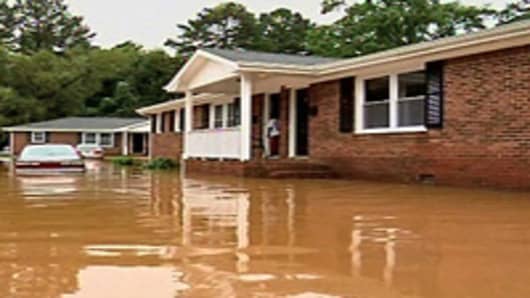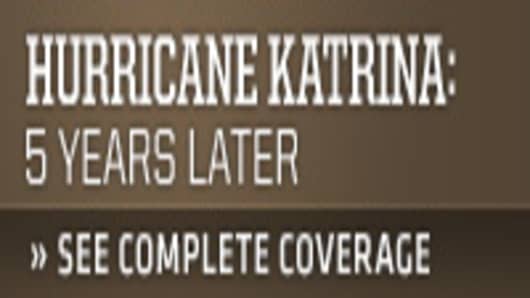The National Flood Insurance Program (NFIP) is one big hurricane away from costing U.S. taxpayers billions of dollars. Experts say unless Congress makes some much needed changes to the program, taxpayers will find themselves footing the bill for another major disaster.
"If you want to design a program to encourage people to take risk, this is the one that does," said Mark Calabria, Director of Financial Regulation for the Cato Institute.
Designed to be self-funded with the premiums it collects from policyholders, for most of its life the program has operated without government aid.
That changed in 2005, when the program had to borrow $18.8 billion from the U.S. Treasury to cover the costs of flood damage linked to Hurricane Katrina and the other big storms that battered the country's southeast region that year.
It is a debt the General Accounting Office speculates the program may never be able to repay, and one that prompted the GAO to put the program on its "high risk" list in 2006.
Operated by the Federal Emergency Management Agency (FEMA), the flood insurance program started in 1968 to serve a dual purpose. First, it was to fill a gap left by private insurers who found it difficult to price policies because of a lack of information about flood zones.
Its second goal was to lower the cost of taxpayer funded flood relief by offering insurance only in communities where local governments agreed to help map flood zones, and to work on other projects aimed at flood protection. Well meaning, the programs structure is flawed in a number of ways, flaws that appear to be fatal in this age of costly natural disasters.
"There are thousands of properties across the country where multiple floods have resulted in payments that exceed and are sometimes multiple times the value of the property."
"Rates need to be raised to reflect the actual risk of flooding," said David Conrad of the National Wildlife Federation (NWF) when asked what reforms are needed in the program. He also said the government could reduce the risk of flood damage by buying risky properties or elevating or relocating certain buildings. He said a a third reform to the program would be to no longer write insurance for buildings that have been flooded a certain number of times.
Right now, 25 percent of the properties insured by the NFIP are grandfathered and pay rates that are 40 percent to 45 percent of market rates. These properties were already in flood zones when the program was started in 1968. Many of these are repetitive loss properties, or properties that have sustained at least $1,000 in flood damage twice in the last ten years.
Because insurance cannot be denied in participating communities, the homeowner of a repetitive loss property bears little risk of the repeated damages, save for inconvenience. It is a gap in the program that can lead to abuse.
"As it stands there are thousands of properties across the country where multiple floods have resulted in payments that exceed and are sometimes multiple times the value of the property," said Conrad, who on behalf of the NWF, has been advocating for flood insurance reform for years now.
The GAO estimates eliminating subsidies to these repetitive loss properties would save the program $891 million dollars by 2015.
Many argue the program needs much more than just monetary savings to survive on its own. Proposals vary from overhauling how NFIP pays insurance agents who sell the policies, to how those policies are priced. Right now, a residential structure can be insured for up to $250,000, and its contents up to $100,000.
Increases on premiums for these policies cannot be increased by more than 10 percent a year, and unlike private insurance policies there are no deductibles. As for the NFIP it cannot buy reinsurance to insure itself against major disasters, and is not set up to put money aside in a catastrophic claims fund.
Advocates for reform say premiums should be increased to reflect the risk undertaken by the program, a proposal that is often rebuffed by members of Congress who hear from constituents the policies are too expensive already. Its one of the reasons lawmakers' attempts to revamp NFIP have stalled in recent years.
"I would eliminate it outright," said the Cato Institute's Calabria of NFIP. "We have a tremendous amount of data out there. This is something the private sector could price and sell and insure on it own, if allowed to price appropriately."
That is a big if. There are some private insurers who underwrite flood insurance, but their numbers are few. Some firms write individual policies, with other insurers like Chubb or Lloyd's of London providing flood insurance for their high-end clients as a courtesy. And it's questionable how willing the industry would be to take on the costs of insuring the most common form of property damage, given the industry's increasing reluctance to insure against wind damage in hurricane prone areas.
What is not in question is that if another Katrina-like storm hits the U.S, the NFIP could find itself having to go back to the Treasury to cover the damages insured by its policies now, policies that don't reflect the risk NFIP assumes. Any solution to this problem, lies in Washington D.C., though, and gridlock is likely to keep signficant changes from happening in the near future.




